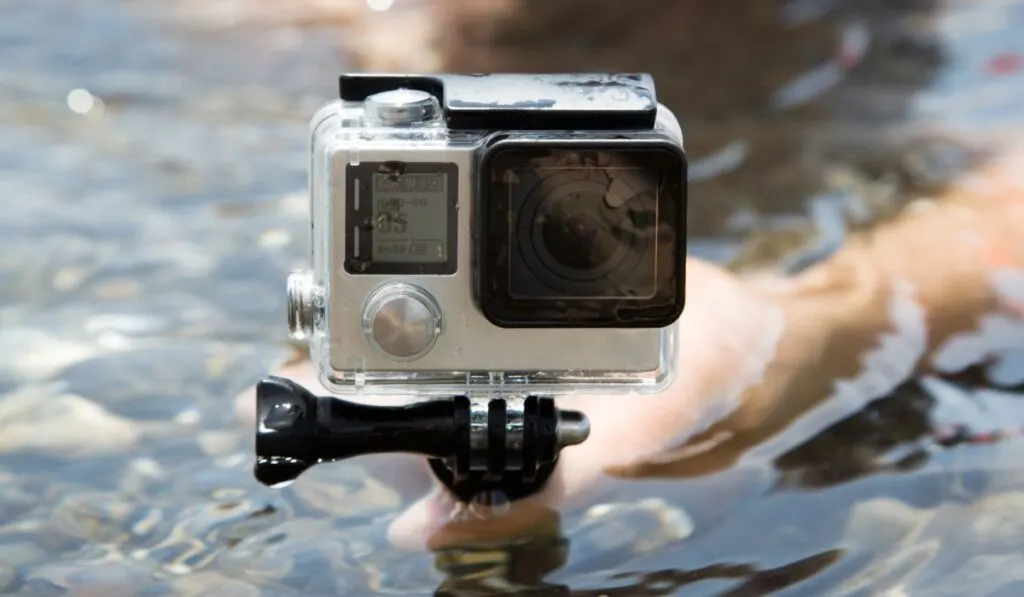One of the many perks of the GoPro camera is that it allows you to take incredible videos and photos in a wide range of environments — including underwater. However, these devices are still susceptible to water damage if you aren’t careful.
All GoPro models since the HERO5 are waterproof with varying depth ratings. Older GoPro models require external waterproof coverings. Be sure to check the seals of your GoPro, use a floating device, and use dive housing if you’re going very deep underwater.
Although GoPros are robust devices that can take a good beating, it’s important to treat them with care. Thankfully, we have some tips and tricks you can use to ensure you’re getting the best water shots while keeping your camera safe.
Are GoPros Waterproof?

Unfortunately, not all GoPros are created equal in this regard. Older GoPro models need external waterproof coverings, while newer models are waterproof to varying depths. By waterproof, we mean that you can dunk the camera underwater right out of the box without any extra external coverings.
Non-Waterproof GoPro Models
- GoPro HERO4 Black/Silver
- GoPro HERO3+
- GoPro HERO3 Black/Silver/White
- GoPro HDHERO2
Waterproof GoPro Models
- GoPro HERO10 Black
- GoPro HERO9 Black
- GoPro HERO8 Black
- GoPro HERO7 Black/Silver/White
- GoPro HERO6 Black
- GoPro HERO5 Black
- GoPro MAX
- GoPro Session
Make sure to check the depth rating of your specific model before you head into the water. Several models, including the HERO10 Black and HERO9 Black, are waterproof to 33 feet (10 meters) with the door closed. Others, like the MAX, are only waterproof to 16 feet (5 meters).
Can a GoPro Go in a Chlorine Pool?
So, you’re trying to take some videos and snapshots of your friends as they dive into the deep end, but you aren’t sure if your GoPro can withstand the harsh chlorine chemicals.
The good news is that all GoPro models since the HERO5 can go underwater in a chlorine swimming pool. However, be sure to rinse your camera off with normal tap water afterward to avoid any unnecessary wear and tear from the chlorine.
Can a GoPro Go In Saltwater?
You’re also in luck if you’re looking to film videos of coral reefs out in the Pacific Ocean. All GoPro models since the HERO5 are perfectly safe to use in saltwater environments. You’ll need to install protective housing for older GoPro models.
Be sure to rinse your camera off with fresh water once you’re done filming. Saltwater can be corrosive and damage your GoPro device over time.
Tips for Protecting Your GoPro in the Water

Although every GoPro model since the HERO5 is waterproof, there are some tips you should be aware of to keep your device in prime condition. The tips below can be used anytime you’re using your GoPro camera near water.
Inspect the Seals
It’s crucial to check the seals on your device’s doors before heading into the water. Although the GoPro is waterproof, the seals on the doors are the first line of defense against damage. If they’re not in good shape, you could have issues.
Ensure the rubber seals around the doors for the USB, HDMI, battery, and SD card compartments are sealed tight. Check for any sand, grit, debris, or tears, and clean the doors if necessary. You can purchase spare doors if you have damaged components.
Don’t forget the lens port, either. Ensure the lens port is securely in place, especially if you’ve frequently been removing it for any dive housing. Remember: Water won’t just ruin your videos; it could also ruin your camera.
Add a Float and Strap
GoPros aren’t very buoyant. In fact, they sink pretty quickly, and they’re hard to find underwater. The best remedy to this problem is to add some kind of floating device to reduce the risk of your camera joining the ocean floor.
You have multiple options for floating devices. You can use a floatation hand grip (on Amazon) that allows you to hold onto something underwater. Another option is floating wrist straps (on Amazon) if you aren’t keen on holding something.
You can also utilize floating cases and housings, but they can be a bit bulky in some cases. Otherwise, your last resort is to use a wrist strap that doesn’t float. This won’t solve the sinking issue but will tether you to your device, reducing the risk that it’ll sink.
Lock the Orientation and Screen
Locking the orientation and screen are two ways you can ensure you’re getting better videos underwater. Your GoPro won’t stay level or upright all the time when you’re swimming. Automatic rotation can kick in and adjust your shot, turning it from horizontal to vertical.
It’s best to lock the touchscreen if you’re near the surface of the water. A touch screen with a few drops of water can cause problems and errors in some cases. The splashes of water might be registered as touches and change the settings, causing frustration in the process.
Use a Dive Housing if You’re Going Deep
Be sure to use your GoPro model recommended dive housing (on Amazon) if you’re going deep underwater. Each GoPro model has varying depth specifications, but several are rated for 10 meters (33 feet). Ten meters is excellent for videos near the surface, swimming, surfing, or light snorkeling.
However, anything deeper, and you’re risking your camera’s seals and safety. Be sure to find compatible dive coverings with your device and follow all the recommended guidelines to avoid unnecessary water damage.
